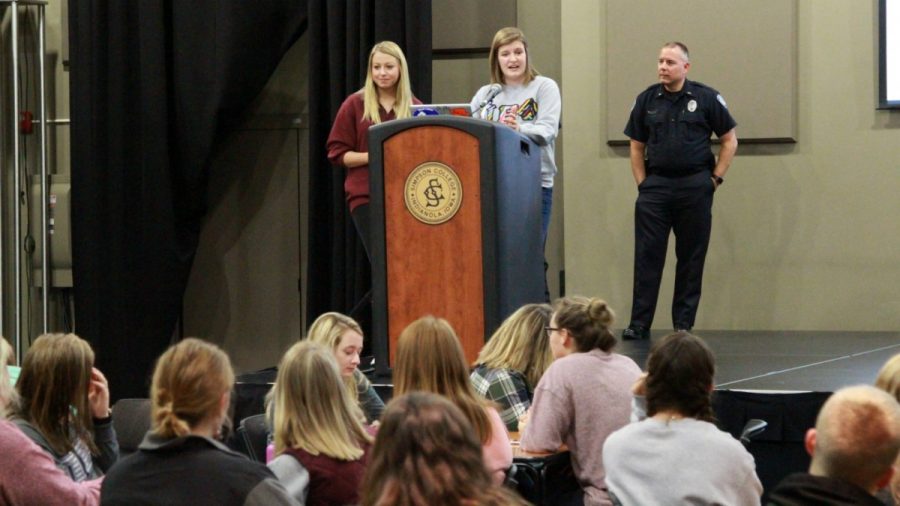Pi Phi takes on distracted driving with Indianola police
October 9, 2017
INDIANOLA, Iowa — Everyone is told not to text and drive or drive while intoxicated. Yet two Indianola police officers say such driving happens much too often.
Lt. Rob Hawkins and Sgt. Justin Keller from the Indianola Police Department spoke Wednesday to students about the risks of distracted driving at Pi Beta Phi’s annual risk management event in the Black Box Theater.
“Pi Phi hosts a risk management event of some kind every year,” said senior Brooke Gowin, a member of the sorority. Last year, she said the topic was mental health.
Junior Maura Saltzman, also a Pi Phi member, said her sorority chose distracted driving as this year’s topic because they thought it was relatable to college students.
Also, since police officers around the country have been under heightened scrutiny recently, Saltzman said, “We wanted to have a good relationship with our local police.”
During their presentation, the police officers did not mince words when explaining the consequences of drunken driving.
“I can tell you that if you’re driving and you’re drunk, you’re going to jail. Plain and simple,” said Hawkins, who has been in law enforcement for 20 years. He said when people choose to drink and drive, they put everybody in danger.
Keller said operating a vehicle while intoxicated was also one of the deadliest traffic offenses. According to him, 968 people were killed in Iowa from OWI-related crashes between 2003 and 2011. Most of those killed were between the ages of 21 and 34.
Nationally, more than 10,000 people died from alcohol-related crashes in 2015 alone.
“That number’s way too high,” Keller said. And to him, that wasn’t even the scariest part.
That same year, he said 1.1 million people were arrested for OWI. But in a national survey, 111 million admitted to drunken driving. In Keller’s words, “We’re only catching a little over 1 percent, or right at 1 percent, of the OWI drivers out there.”
Many different factors determine how alcohol affects a person, Keller said. These factors include body weight, quantity and type of alcohol drank, how long ago the person drank, what their sex is and whether or not they mixed the drink with medication.
In order for someone 21 or older to legally drive in Iowa, their blood alcohol content must be .08 percent or lower. However, with a BAC of as much as .02 percent, or about two drinks, Keller said a person may already experience slight loss of judgment, impaired visual function and reduced ability to multitask.
As their BAC increases, their ability to drive safely decreases accordingly. At .08 percent, a driver would have difficulty concentrating, controlling their speed and processing information.
In a traffic stop, Keller said officers will conduct multiple field sobriety tests to determine how intoxicated a driver is. These tests involve looking at the driver’s eyes to see if they are involuntarily jerking back and forth due to alcohol, instructing the driver to try walking in a straight line or balancing on one leg. After that, police typically perform a breath test to determine the driver’s BAC.
Keller said there are two ways arrests can be made in Iowa: if the person has a BAC over the legal limit or if they are too impaired to drive due to factors besides alcohol, such as recreational drugs or medications. For a driver under 21, a BAC greater than .02 percent would put them in violation of the law and they could temporarily lose their license.
While drunken driving is illegal and risky, texting while driving can be just as bad.
“Statistically, texting and driving is just as dangerous, if not even more dangerous because so many people are more likely to pull out their device and text than they are to get behind the wheel after they’ve been drinking,” Keller said.
Since drivers may not always confess to texting, he said law enforcement officials have no way of knowing for certain how many accidents they respond to as a result of drivers texting.
“Texting and driving is kind of the new OWI,” Keller said, later comparing it to a driver having a BAC of .10 percent.
After the officers concluded their presentation, they invited the audience of about 50 students to simulate drunken and distracted driving outside Kent on tricycles.
“It was bad. I ran over multiple cones,” Saltzman said. “It really puts in perspective how much you’re not looking at the road or what’s in front of you and how much time you actually look at your phone.”
While Saltzman and several of her Pi Phi sisters had fun doing the simulations, they hoped everyone took away the seriousness of distracted driving and also how little alcohol it takes to become impaired.






